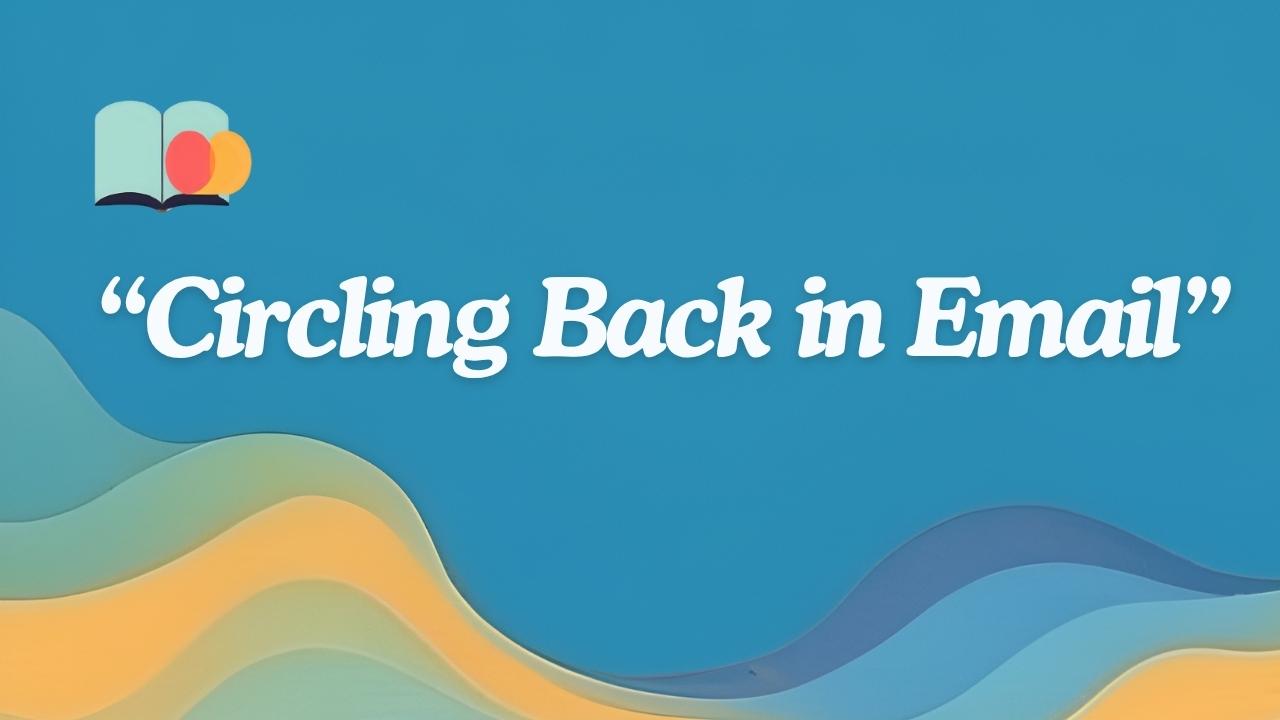Ever sent an email and thought “circling back” sounds old? You’re not alone. This phrase is often used but can feel stale. Finding new ways to say it keeps your emails fresh and polished.
Whether you’re checking in with a colleague or following up with a client, using different words shows you’re creative and professional.
Here’s a quick look at some alternatives:
following up,
touching base,
checking in,
reaching out,
and revisiting.
This guide has 50+ creative ways to say “circling back” in an email, with examples and tips to make your emails better.
Why Use Alternatives to “Circling Back”?
“Circling back” is common in emails but can sound robotic. Using different words helps you:
- Sound polished: Using varied language shows you care about details.
- Match tone: Different phrases fit different situations, from formal to casual.
- Avoid repetition: New phrases keep your emails interesting.
Let’s explore some alternatives for professional emails, sorted by tone and situation.
Professional Alternatives to “Circling Back” in Emails
Formal and Professional Alternatives
These phrases are great for work emails, talking to clients, or school. They keep your tone polished while showing you’re following up.
- Following up [Professional]: Simple and direct, perfect for formal emails.
Example: “I’m following up on our discussion about the project timeline.” - Checking in [Professional]: Friendly yet professional, great for ongoing projects.
Example: “Just checking in to see if you’ve reviewed the proposal.” - Reaching out [Professional]: Versatile for starting or continuing a conversation.
Example: “I’m reaching out to confirm next steps for the campaign.” - Revisiting [Formal]: Suggests a thoughtful return to a previous topic.
Example: “I’m revisiting our conversation about budget adjustments.” - Touching base [Professional]: A classic, slightly less formal option.
Example: “I wanted to touch base regarding the client feedback.” - Following through [Professional]: Shows you’re committed to action.
Example: “I’m following through on the action items from our meeting.” - Checking on the status [Formal]: Specific and goal-oriented.
Example: “I’m checking on the status of the contract approval.” - Resuming our discussion [Formal]: Ideal for picking up a detailed conversation.
Example: “I’d like to resume our discussion about the Q3 goals.” - Returning to [Formal]: Suggests a deliberate revisit to a topic.
Example: “I’m returning to the topic of resource allocation.” - Providing an update [Professional]: Focuses on sharing progress.
Example: “I’m providing an update on the marketing campaign’s progress.”
💡 Expert Tip: For formal emails, pair these phrases with specific references to prior conversations (e.g., “from our March 10 meeting”) to show attention to detail.
Similar Posts
Casual and Friendly Alternatives
These phrases are good for team emails or less formal client talks. They keep things friendly while staying professional.
- Pinging you [Casual]: Informal and quick, great for team chats.
Example: “Just pinging you about the design mockups.” - Dropping a line [Casual]: Friendly and conversational.
Example: “I’m dropping a line to see where we’re at with the report.” - Catching up [Friendly]: Suggests a relaxed check-in.
Example: “Thought I’d catch up on the project timeline.” - Looping back [Casual]: A playful nod to “circling back.”
Example: “I’m looping back to confirm the meeting time.” - Checking back [Friendly]: Simple and approachable.
Example: “Just checking back on your thoughts about the proposal.” - Giving a nudge [Casual]: Lighthearted, good for gentle reminders.
Example: “I’m giving a nudge about the feedback you mentioned.” - Popping in [Friendly]: Informal and warm.
Example: “Popping in to see if you’ve had a chance to review the draft.” - Swinging by [Casual]: Playful, best for familiar colleagues.
Example: “Just swinging by to check on the presentation slides.” - Following back [Casual]: A relaxed twist on “following up.”
Example: “I’m following back on our chat about the event.” - Bouncing back [Friendly]: Energetic and informal.
Example: “Bouncing back to see if you’re ready to finalize the plan.”
✅ Best For: Use casual phrases with colleagues you know well or in less rigid work cultures to keep communication warm and engaging.
Urgent or Action-Oriented Alternatives
When time is tight or you need a response, these phrases convey urgency without being pushy.
- Following up urgently [Urgent]: Direct and time-sensitive.
Example: “I’m following up urgently on the contract deadline.” - Checking in promptly [Urgent]: Polite but firm.
Example: “I’m checking in promptly about the payment status.” - Reaching out again [Urgent]: Suggests a second attempt.
Example: “I’m reaching out again regarding the approval needed by Friday.” - Pressing for an update [Urgent]: Direct, for critical matters.
Example: “I’m pressing for an update on the project deliverables.” - Requesting a status update [Action-Oriented]: Formal and clear.
Example: “I’m requesting a status update on the client proposal.” - Seeking clarification [Action-Oriented]: Focuses on resolving ambiguity.
Example: “I’m seeking clarification on the budget changes discussed.” - Prompting for feedback [Action-Oriented]: Encourages a response.
Example: “I’m prompting for feedback on the revised draft.” - Reaching out for confirmation [Action-Oriented]: Specific and goal-driven.
Example: “I’m reaching out for confirmation on the meeting schedule.” - Checking in on progress [Action-Oriented]: Focuses on forward movement.
Example: “I’m checking in on progress for the website launch.” - Re-engaging on [Urgent]: Suggests restarting a stalled conversation.
Example: “I’m re-engaging on the timeline for the product rollout.”
⚠️ Mistake to Avoid: Don’t use urgent words too much. They can seem too pushy or demanding.
Alternatives by Tone
| Phrase | Tone | Best Context | Example Use Case |
|---|---|---|---|
| Following up | Professional | Client emails, formal follow-ups | Checking on a proposal’s status |
| Touching base | Professional | Team check-ins, ongoing projects | Confirming project milestones |
| Pinging you | Casual | Internal team emails | Quick nudge about a shared task |
| Dropping a line | Friendly | Informal client or colleague emails | Checking in on a casual project |
| Following up urgently | Urgent | Time-sensitive matters | Pressing for a deadline-driven response |
| Seeking clarification | Action-Oriented | Resolving unclear points | Clarifying meeting outcomes |
This table helps you pick the right phrase based on your email’s tone and purpose.
Usage Tips for Saying “Circling Back” Differently
When to Use Each Type
- Formal phrases: Use in emails to executives, clients, or academic contacts. They signal professionalism and respect.
- Casual phrases: Best for internal teams or familiar clients. They build rapport and keep things light.
- Urgent phrases: Reserve for time-sensitive situations or when you’ve already followed up once without a response.
Cultural Considerations
- In U.S. and U.K. business settings, phrases like “touching base” or “following up” are widely understood.
- In non-English-speaking regions, avoid idioms like “looping back” or “popping in,” as they may confuse recipients. Stick to clear phrases like “checking in” or “following up.”
- For global teams, include context (e.g., “I’m checking in on the project we discussed last week”) to avoid ambiguity.
Email Etiquette Tips
- Be specific: Mention the topic or date of the prior conversation (e.g., “Following up on our June 5 call”).
- Keep it concise: Pair your alternative phrase with a clear call to action (e.g., “Please confirm by Friday”).
- Use a friendly sign-off: Pair phrases like “dropping a line” with warm closings like “Best regards” or “Looking forward to hearing from you.”
More Creative Alternatives to “Circling Back”
For those wanting to stand out, these creative alternatives add flair while staying professional.
- Reconnecting on [Creative]: Suggests a warm re-engagement.
Example: “I’m reconnecting on the marketing strategy we discussed.” - Tying up loose ends [Creative]: Implies finalizing details.
Example: “I’m tying up loose ends on the event planning.” - Getting back to you [Friendly]: Conversational and approachable.
Example: “I’m getting back to you about the budget approval.” - Picking up the thread [Creative]: Suggests continuing a conversation.
Example: “I’m picking up the thread on our project timeline.” - Revisiting the matter [Formal]: Polished and precise.
Example: “I’m revisiting the matter of the contract terms.” - Checking in again [Friendly]: Softens a repeated follow-up.
Example: “I’m checking in again about the feedback you promised.” - Reaching out anew [Creative]: Fresh and engaging.
Example: “I’m reaching out anew to discuss the next steps.” - Following up afresh [Creative]: Suggests a new angle.
Example: “I’m following up afresh with some updated ideas.” - Re-engaging with [Professional]: Polished and action-focused.
Example: “I’m re-engaging with you on the product launch plan.” - Looping in again [Casual]: Playful yet professional.
Example: “I’m looping in again to confirm the meeting details.”
💡 Expert Tip: Creative phrases work best when you know the recipient appreciates a unique tone. Test them in less formal settings first.
FAQ: Common Questions About Saying “Circling Back” in Emails
What’s a polite way to say “circling back” in an email?
Polite alternatives include “following up,” “checking in,” or “reaching out.” For example: “I’m checking in on the status of the report.”
How do I follow up without sounding pushy?
Use friendly phrases like “touching base” or “dropping a line” and include a specific reason, like: “I’m touching base to see if you’ve had a chance to review the draft.”
Can I use “circling back” in formal emails?
Yes, but it’s better to use more precise phrases like “following up” or “resuming our discussion” for a polished tone.
What’s a casual alternative to “circling back”?
Try saying “pinging you” or “catching up.” For example: “Just pinging you about the project timeline.”
How often should I follow up on an email?
Wait 3–5 business days for a first follow-up. Use phrases like “checking in again” for more nudges. Always keep it polite.
Conclusion
Looking for a different way to say “circling back” in emails? It can make your messages stand out. This list has 50+ options for every situation.
Use these tips and examples to match the recipient’s style. Do you have a favorite phrase? Share it in the comments! We want to hear your ideas.
For more tips on improving your emails, check out Waystosay.org.





